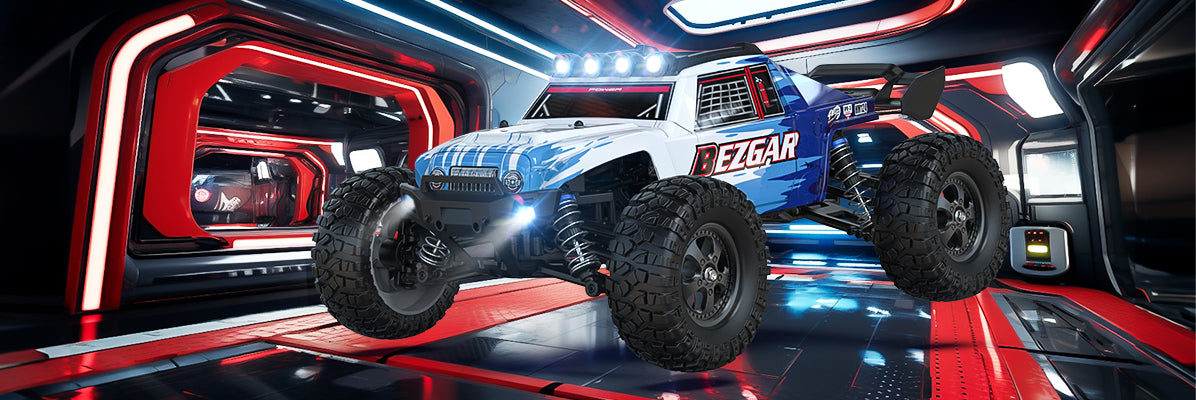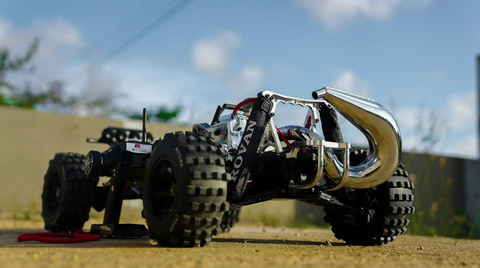
How to Inspect and Replace RC Car Tires and Wheels
Behind every exciting remote-controlled (RC) car race is a solid set of tires.
That's right; it doesn't matter what engine you're running, how lightweight your chassis is, or what battery is juicing the lot; if you don't get the right tires in place for the car you have and the terrain you're running over, you're not going to have a positive experience.
You need to ensure you get it right.
Imagine being an RC hobbyist, driving your RC car over rugged trails, sandy beaches, or race tracks. The thrill partly comes from how well the car handles, speed, and overall performance.
And guess what? The correct set of tires and wheels significantly contribute to these factors.
In this guide, we'll unveil the secret to boosting your RC car's performance through regular inspection and replacement of your RC car tires and wheels. Everything you need to know to make the best decisions and give yourself the next RC driving experience possible.
Jump in, and let's get those tires rolling!

Understanding RC Car Tire Basics
RC car tires are more than just rubber on wheels; they are the deciding factor in your vehicle's performance. Here's why understanding tire basics is crucial:
- Tire Types and Textures: The make-up of your RC car tires – from slicks for smooth surfaces to knobby tires for off-road traction – can dramatically influence speed, grip, and the ability to control your vehicle.
- Wheel Types: Wheel construction varies greatly, from plastic, which is lightweight, to aluminum, which offers durability and heat resistance. The choice of wheel material affects your RC car's weight distribution and stability.
- Overall Handling: Tires and wheels work in tandem to affect handling. A perfect match between the two means better car control and optimized performance during different driving conditions.
Regular Inspections: The Key to Long-lasting RC Car Tires
Caring for your RC car is akin to a labor of love! Regular inspections of your RC tires and wheels are indeed the secret to extending their life. Let's break it down:
- Inspection Process: Develop a keen eye for detail. A good start is by checking for punctures, tread wear and tear, or any deformities on both the tire and the wheel.
- Site the Signs: Recognising signs of wear and tear is crucial. Distorted treads, deep cracks, thinning, and uneven wear patterns suggest it's time for some action.
- To Repair or Replace?: Depending on the damage, tires can either be repaired with quick fixes or replaced entirely. Strive for a balance between cost-effectiveness and maintaining optimal performance.
Tools of the Trade: What You'll Need for Inspection and Replacement
Having the right tools is vital for efficient inspection and replacement of your RC car tires:
- Necessary Tools: Equip yourself with a tire removal tool or a wrench that suits your wheel's nut size, tire glue for reattachment, and a soft brush for cleaning.
- Optional Tools: Tire balancing tools and tire traction compounds can add precision and ease to your maintenance process.
- Proper Storage: Keep your tools organized and easily accessible using a tool bag or a toolbox, ensuring a smooth and efficient tire inspection and replacement experience.
Step-by-Step Guide to Inspecting RC Car Tires
Adequate inspection ensures your tires are always ready for action. Follow these steps for a comprehensive check-up:
- Tread Depth and Patterns: Begin with examining the tread depth using a tread gauge or simply by visual inspection. The pattern should be distinct and deep enough to handle the intended terrain.
- Sidewall Health: Inspect the sidewalls closely for any signs of damage, such as cuts, punctures, or bulges, which could compromise the tire's integrity.
- Abnormal Wear: Be alert to uneven wear, which could point to issues with alignment or suspension. Such wear can reduce your RC car's performance and may lead to frequent replacements if not addressed.
Removing Old Tires and Wheels Like a Pro
Mastering the art of removing old tires and wheels can save you time, effort, and unnecessary damage. Here's how to do it like a pro:
- Safe Removal Techniques: Start by loosening the wheel nuts using a fitting wrench. Remove the tire slowly by applying even pressure around edges to avoid deformation.
- Handling Difficult Tires: For stubborn tires, use a tire removal tool or apply a little heat (avoid burning the rubber) to ease off the tires without causing damage to the wheels.
- Preparing Wheel Hub: Once the tires are off, clean and prepare the wheel hub for attaching new tires. Remove any previous glue remnants and ensure the surface is smooth and dust-free for maximum adhesion.
How to Choose the Right RC Car Tires and Wheels
Selecting the right RC car tires and wheels is key to performance. Here are some factors to consider when buying new ones:
- Tire compound: Affects grip and durability. Softer tires provide more traction but wear quickly. Hard tires are durable but offer less grip.
- Tread pattern: Different patterns work best on different surfaces. Understand the track to pick the right one.
- Tire size: Larger tires give higher speeds, while smaller ones offer better control.
- Wheel offset: More offset gives a broader stance, improving stability. But, it increases tire wear.
Oh, and don't forget to consider the terrain you're driving on. Even if you're switching the terrain from one hour to the next, switching over to a more suitable set of tires will make a huge difference.
Here's a little lowdown of what you need to know:
- Asphalt: Look for street treads or slicks with a soft compound.
- Dirt: Choose a robust tire with an aggressive tread pattern.
- Grass: Use large, wide tires with tall treads for increased traction.
- Rock: Opt for high grip, soft compound tires with a robust tread pattern.
Balancing Performance Needs with Durability
- Use: Racing tires deliver superior performance but wear out faster. Bashers offer durability at a slight cost to performance.
- Budget: Higher performance often comes with a higher price. Consider how often you'll replace the tires.
The Replacement Process: Mounting New Tires and Wheels
The tire and wheel replacement journey culminates when new ones are mounted. Here's how to do it flawlessly:
- Attaching Tires to Wheels: Begin by applying a thin layer of tire glue in the wheel's bead area. Then, align the tire on the wheel. Carefully press and hold the tire and wheel together while the glue dries. Repeat this process around the perimeter of the wheel.
- Fitting Wheels on Axles: Align the wheel hub with the axle, ensuring the holes line up. Once aligned, insert the wheel nut and tighten using a fitting wrench.
- Securing the Tires: Take a final inspection. Make sure the tires are secure on the wheels, all nuts are firmly tightened, and the wheels spin freely. Now, your RC car is ready to dominate any terrain.
Post-Replacement Tips for Optimal Performance
Once the new wheels are on board, caring for your RC car doesn't stop there.
- Testing After Replacement: Immediately post-replacement, test the RC car in a controlled setting. Look for even motion, good grip, and accurate steering responses to ensure everything is fitted correctly.
- First Drive on New Tires: Take it slow during the tire's first drive. This helps the tires to find their grip, while you adapt to the car's possibly altered handling.
- Ongoing Maintenance: Regularly clean the tires, check alignment, and assess the wear pattern. Proper storage can also keep your tires in top shape longer. Remember, prevention is always better than cure!
Taking care of your RC car is a skill acquired through constant learning and practice, so keep experimenting and enjoy the journey!
Troubleshooting Common Issues After Replacements
Even after a perfect replacement, there could be a few hiccups. Here's how you can troubleshoot common post-replacement issues:
- Addressing Alignment Problems: Uneven wear indicates alignment problems. Check and adjust the alignment of the wheels. Regular alignments can improve driving and increase the lifespan of your tires.
- Solving Imbalanced Tires and Wheels: If your RC car wobbles or vibrates, the tires could be imbalanced. Use a tire balancing tool to correct this. Sometimes, rebalancing the tires can resolve this issue.
- Ensuring Proper Torque on Wheel Fasteners: A loose wheel can cause serious damage. Make sure the wheels are secure and tight on the axles. An adequately torqued wheel nut ensures your wheel stays intact throughout your race.
Conclusion
Ready to elevate your RC experience? Discover the exciting world of Bezgar.com and explore a wide range of RC cars, trucks, boats, quadcopters, drones, and smart robot toys that blend speed, performance, and durability to offer you an unforgettable adventure.
At Bezgar, we prioritize customer satisfaction with our top-notch support and provide a seamless one-stop shopping experience. Enjoy 100% secure payments along with free shipping on orders over $88.
Are you waiting for the perfect moment to kickstart your RC racing journey or expand your collection? The time is now!
